2014 Harley-Davidson Low Rider Review – First Ride

Modern updates with a 1970s appeal
When introducing a new motorcycle, many manufacturers lead off with all the technical marvels they’ve packed into their latest offering. Harley-Davidson often begins with talk of the style of its new motorcycle and how it ties to the company’s history. Being one of the largest motorcycle manufacturers in the world certainly says something about the success of the motor company’s development model.
2014 Harley-Davidson Low Rider
| Engine | 18.25/20 |
| Suspension/Handling | 12.5/15 |
| Transmission/Clutch | 8.5/10 |
| Brakes | 8.25/10 |
| Instruments/Controls | 4/5 |
| Ergonomics/Comfort | 9/10 |
| Appearance/Quality | 9/10 |
| Desirability | 9/10 |
| Value | 8/10 |
| Overall Score | 86.5/100 |
So, when the representatives at a Harley new model press briefing mention styling first, it should come as no surprise. Reintroducing a model that was first released in 1977 (at Daytona Bike Week, no less) after it has been on a five year hiatus, Harley naturally calls upon the bike’s past heritage (by, maybe, introducing it at Bike Week) before outlining how it’s been modernized with a more powerful engine and a refined chassis.
1997 Harley-Davidson Dyna Low Rider – And A Brief History Of The Low Rider Models
In the Heritage Department, the Low Rider wears some unmistakable styling touches that were featured in the original FXS model of the Low Rider. Take a gander at the polished headlamp visor or eyebrow (as it was referred to in the press briefing). The polished fork and the tiny front fender carry a family resemblance. How about those split five-spoke aluminum wheels, featuring both machined aluminum and wrinkled black paint? Hey, the engine gets the same wrinkle paint, machined metal look, too. The chromed 2-into-1 exhaust has the same bad attitude of the original. Yep, theme duly noted here.
The Low Rider has always been about hot-rod-styled performance wrapped in an attention-getting chassis (most recently the Dyna chassis) that just so happens to fit shorter riders. However, when addressing the FXDL’s past style, Harley’s engineers gave themselves some technological challenges to puzzle over. The biggest task was the desire to have the Low Rider fit riders ranging in height from 5’1″-6’1″. Yes, an entire foot difference in height. Most American riders don’t know that, although the Low Rider has been shelved domestically for the past five years here, it has continued to sell – and sell well – in the Japanese market. Since Japanese are typically shorter than Americans, the size spread begins to make more sense.
The Low Rider was designed to fit every body size between a Japanese female who measures in the 50th percentile of height for a Japanese woman while the 6’1″ top end of the equation settles in at the 90th percentile height of American men. So, the FXDL is supposed to fit riders ranging from a mid-sized Japanese woman to an above average height American man. Considering the variables of arm, leg, and torso length, this is an astonishing challenge. To find out what the needs of riders in the market for a bike like the Low Rider were interested in, Harley used the same customer-focused process they developed for Project RUSHMORE.
The puzzle presented by the Low Rider is really a question of ergonomics. How does a single motorcycle accommodate such differing body types? In the end, Harley did it with some good old American ingenuity, the key of which was the all-important rider triangle. The handlebar, seat and pegs constitute the primary contact points with the rider. Within these points the physical limitations of the differing body sizes needed to be accommodated. If the pegs were in a fixed location (though ultimately two inches forward from their previous location), then the points available to change by the riders themselves were the grips and the seat. Both were addressed in simple but clever ways.
Using computer models, the design team was able to overlay the two extremes of the rider triangles onto the chassis in order to calculate the range that the two variables needed to support. Once those were determined, the trick was to make the bike easily adjustable. For example, Harley could have sold the Low Rider with a seat option for shorter and taller riders. Many manufacturers do this. Instead, a seat was created with a means of changing its size to fit smaller riders.
The FXDL’s seat has a spiffy chrome Harley badge inset into the lumbar section of the seat. However, what looks like a nice styling touch is really a cover. Lifting the seat reveals two screws positioning the badge. When these are unscrewed, mounting points under the badge are exposed that secure a bolster which moves the back of the seat 1.5 inches forward. Reaffixing the badge holds everything neatly in place. This mode of adjustment is much more convenient for both the customer (who isn’t forced to make a choice at the time of sale) and the manufacturer (who only needs to build and track one seat).
The handlebar position is given infinite variability within a 2.4 in. range thanks to a clever riser assembly. In an arrangement that looks somewhat like dog bone risers (only bent about 60 degrees), the adjustment comes from clamps located just above the triple clamp. Then the risers themselves pivot forward and rearward through the range of adjustment. Atop the risers a pair of clamps hold the handlebar itself. Adjusting the bar position is as easy as loosening two allen bolts and adjusting the tilt of the risers. Once they’re tightened in position, loosen two handlebar bolts and rotate the handlebar until the grips are in the desired location. Total time is just about two minutes!
To a 5’11” rider, having the risers in the foreword-most position feels a little like the reach to a drag bar. In the full rearward position, the grips feel a bit too rearward to the same rider. Fine tuning to find the sweet spot takes seconds. Adjusting the seat only takes a phillips head screwdriver though this only moves the rider forward. The seat height itself is a modest 25.4 in. The narrowness of the front of the seat gives the rider the feeling of an even lower seat.
The upgrades to the Dyna chassis focused on the suspension bits. The stated goal was to find the right balance between riding comfort and control. Given that the FXDL is viewed as a performance model, when the conflicting goals conflicted with each other, the nod was given in the direction of control. Both the fork and the shocks have tri-rate springs. The initial rate is quite soft to address rider comfort over smaller road irregularities. The next two rates are progressively firmer, allowing better control over larger bumps. In the 49mm fork, the firmer spring rates also minimize brake dive into the 5.1 in. of travel, giving the rider more confidence during aggressive braking.
Visually, the shocks are striking with their black body and springs capped with chrome. The firmer of the three spring rates are directed more towards handling. If the springs are too soft, the bike will be wobbly under cornering forces. Too firm and the ride will be overly harsh. The adjustable rear preload is designed to move the suspension to the firmer spring rates earlier as the Low Rider is asked to carry heavier loads. With only 3.1 in. of travel, the rear suspension doesn’t have a lot of room to work its magic. Still, in our day’s ride on the Low Rider worked well in a variety of riding conditions.
While never feeling harsh for a 170 lb. rider on the interstate, highway or around town, truth be told, the roads we covered in rural Florida were pretty smooth, so it’s hard to get a feel for how the FXDL will behave in bumpier environments. Will the shocks bottom easily, like other Dynas we’ve tested? We did manage to navigate the eleven corners in the entire state of Florida, and again, with this limited sampling, the only thing holding the Low Rider back in corners is ground clearance typical of cruisers. The pegs drag, giving the rider some warning – a particularly important one on the right side, where the leading edge of the muffler can touch down hard. Steering response is good for a big, heavy cruiser regardless of whether we were changing lines mid-corner or changing lanes on the freeway. We look forward to get a unit for a proper test in the future.
One area that the fun factor is immediately apparent is the Twin Cam 103 engine, which is standard in most Dynas. We’ve sampled this 103/Dyna combination before and have always come back impressed. The exhaust note is throaty for a stock unit. The engine’s rubber mounts quell most of its vibration even at elevated highway speeds. The torque curve means that, if you’re feeling lazy as you roll through one of those quarter-mile-wide towns you find on rural highways, you don’t really have to downshift and can chuff through the reduced speed zone before rolling back up to speed.
The Low Rider’s dual 300mm front discs deliver whoa-power when you need it. The four-piston calipers offer plenty of feel and ease of modulation. Steering under braking is easy, thanks to the fork and the carcass shape of the Michelin Scorcher tires. The two piston caliper and 292mm rear disc are unremarkable, simply getting the job done without any fuss. The optional $795 ABS on the model tested worked as you’d hope it would – unobtrusively. However, the location of the brake pedal leaves a lot to be desired. The pedal is difficult to operate because it is slightly below the foot peg and almost requires that the heel be lifted off the peg. The smoothness of the pedal surface exacerbates the problem in the wet where, without a heel hooked on the peg, the rider’s foot can slip off the pedal. It’s hard to believe that the same company that created the clever handle bar risers on the Low Rider is responsible for the brake pedal.
Overall, our short time with the Low Rider revealed a bike that has tons of attitude and the performance to back it up. With a base price of $14,199 in Vivid Black, the FXDL is cool looking, but you owe it to yourself to pop for the two-tone Brilliant Silver/Vivid Black or the stunning Amber Whiskey/Vivid Black for $14,929. The 2014 Harley-Davidson Low Rider has made an entry into the market that is worthy of the original model. Go try this bike’s attitude on for size.
+ Highs
- Adjustable ergonomics
- Great engine
- 1970s style
– Sighs
- Not enough ground clearance
- Funky brake pedal location
- ABS is not standard

Like most of the best happenings in his life, Evans stumbled into his motojournalism career. While on his way to a planned life in academia, he applied for a job at a motorcycle magazine, thinking he’d get the opportunity to write some freelance articles. Instead, he was offered a full-time job in which he discovered he could actually get paid to ride other people’s motorcycles – and he’s never looked back. Over the 25 years he’s been in the motorcycle industry, Evans has written two books, 101 Sportbike Performance Projects and How to Modify Your Metric Cruiser, and has ridden just about every production motorcycle manufactured. Evans has a deep love of motorcycles and believes they are a force for good in the world.
More by Evans Brasfield



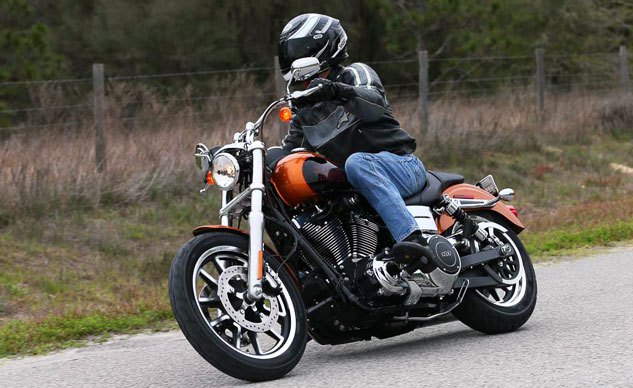
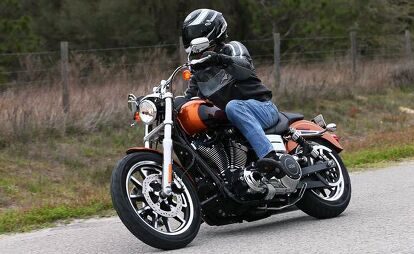







































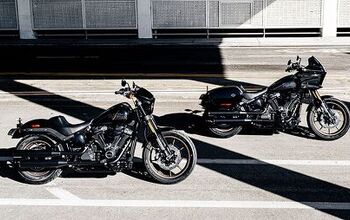
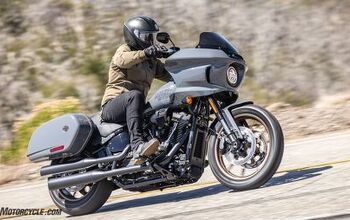


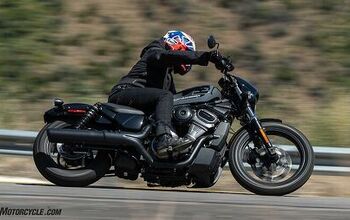












Comments
Join the conversation
Negatives.
1. No hydraulic clutch
2. No oil cooler
3. No ABS included
4. No adjustable suspension
4. $17,000 w/ABS, setup, & tax & none
of the above.
I'm an HD guy, but this is exorbitant for
a very basic 'big twin' machine
I took this bike on a test ride and loved it. I've owned, ridden or raced pretty much every bike there is over the last 50 years, have been riding since I was 6 and was losing interest lately, my current bikes are sitting in the garage but the thrill is gone, sure I ride them but it's not great fun any more. Every bike I look at now doesn't seem to have a visible motor, sure they're faster, handle better and are techno marvels but they don't seem to have soul. I love looking at motors and this Low Rider seems to be about the only bike left except for other Harleys which have a motor you can actually see. Everything I've looked at or own lately is covered by fairings or looks like a plumbing and electrical nightmare, look like transformers and hurt my butt on anything over a 20 minute ride, they are faster than snot, wheelie for days, smooth but boring at the same time. This one is basic, comfortable, stops, goes, looks and sounds great. I haven't enjoyed doing the speed limit this much since riding my Ruckus. This is all I want for now, a bike that is comfortable and has a bunch of torque. Another good thing about it is they got rid of the spindly forks that my buddys dyna has so it handles better which is something I felt as soon as I started riding it and it has dual discs unlike practically every other model. I've never owned a cruiser but this is the least cruisey cruiser I could find. No, I don't need the "lifestyle", I'm not a billboard and am not a club kinda guy, I just like to ride. This is my next bike, just have to sell others first :(
Edit: Just to make sure I wanted this bike I took it out for another test ride on the freeway this time, it felt like my back was broken after I was done, the suspension pretty much sucks, every bump and expansion joint jarred my back and neck, it was like a jackhammer and at one point my left foot was jolted off the peg and I had to fight to keep them on between wind, vibrations and bumps. I wanted to like this bike but between the cruiser position and terrible suspension this bike is not for me, it just feels downright dangerous and that pretty bad considering all of the bikes I've owned and ridden in my life. Suspension work is not an option after having to spend about $18,000 on a bike that should be sorted out before it goes out the door at that price. Pretty much the only thing this bike is good for is going 45 mph tops, on smooth roads. It's a shame, I really did like the motor for the low end. C'mon Harley, make a bike for the rest of us.